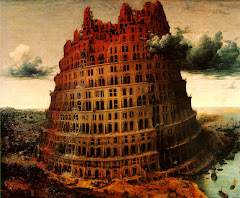Language has its uses. I am among those who largely eat, sleep, and breathe the stuff. So when I rage against the traps and limitations inherent in reducing life (as we know it) in the real world (as we know it) to its verbal explanations, I'm counting myself among the afflicted. So I'm here to admit that I have a problem, to acknowledge that I am powerless to overcome this problem on my own, and to begin the process of recovery. My name is Sven and I'm verbocentric.
I've been running into a lot of situations where someone else (not me!) complains about a discrepancy between their theory/belief/postulate/assumption/definition of x and an observable phenomenon y. The common reaction is that there must be something terribly wrong with y because it doesn't match x, the major premise being, of course, that x is true. "I'm surprised that you'd have that reaction because you're (leftist/male/counterculture/educated/white person)." Like my every attitude and behavior ought to follow from whatever category I've been slotted into.
I'm not sure what a technical philosopher would call this, but it reminds me of debates between rationalists and empiricists, positivists and pragmatists, or the early and the later Wittgenstein. Whatever, I don't want to go there, and chances are you don't want to either. What irritates me is the expectation that any explanation of the facts could be final.
Words can, at best, define other words. They don't define the things and events that other words attempt to describe, explain, compare, etc. The elusive people, places, things, and events are more slippery than that, so on a good day human descriptions in language can only come close.
My gifted spouse Gven Golly, who by the way was born on Norwegian Independence Day, or Sittende May [pronounced SIT-uhn-da MY, or May 17, for you non-Norwegian speakers], exemplifies the opposite human type, let's call it spatiocentric. She is not afflicted with verbocentrism and thus provides me with a daily antidote in the form of nonlinear, nonlogical, nonrational thinking, which can be expressed verbally but does not attempt to reduce the world to what's in a sentence. Which most of the time drives me crazy and once in a while solves a sticky problem.
Yesterday, for example, we were in the middle of a decidely nonverbal task, connecting the woodstove to the chimney. Gven and Jessi had moved the iron stove out of the den to tile the floor, and now that the tile is finished (thanks to crafty Gven and her crafty son), it's time to make the stove functional again, and that requires a nice, tight stovepipe. It took the two of us a long time to find a way to position the stove under the chimney while fitting two sections of stovepipe snug between the stove (on floor) and chimney (in ceiling/roof). This involved sliding the stove across the nice, new tiles on a piece of (nonstick, nonscratch) felt, then deadlifting the stove, two legs at a time, onto bricks so the pipe would not leave gaps. We finally got it connected, but it took some doing and revealed a bit of flawed logic in my own engineering skill, for which the polite term would be developmentally delayed.
Long story short, we puzzled over how to fit a certain length of pipe into both stove below and chimney above. My ideas all came in the form of abstract, if-then statements, like a mechanical drawing of an actual object or plays drawn up on a blackboard. Her ideas were not as linear, logical, or precise, and not based on the Pythagorean theorem, but lo and behold, some of them worked. Her proposed solutions to the mechanical problems posed by solid objects in a finite space defied any explanation either one of us could conjure up. But sure enough, some of them brought solid metal object together in ways that my rational calculations said would not, could not, work. The stove is in place, just in time for cold weather. Don't ask me how or why.
Monday, November 21, 2005
Subscribe to:
Post Comments (Atom)

1 comment:
I read an article a few years ago about the inability of linear (western) text to handle the increasing demands of information content. The alphabet was an amazing invention in its day, but the author proposed that something more graphic, like Chinese pictographs, might solve some approaching problems with thhe volume of messages sent and stored. That's still two-dimensional text, not as radical a change as you're suggesting, but might be a step in that direction.
Post a Comment